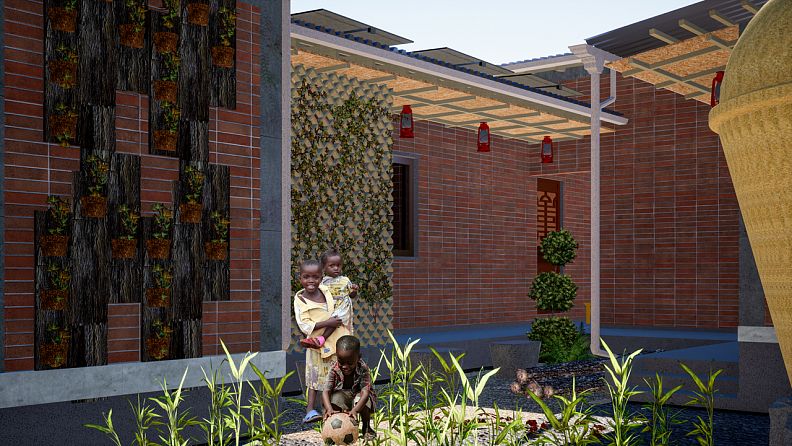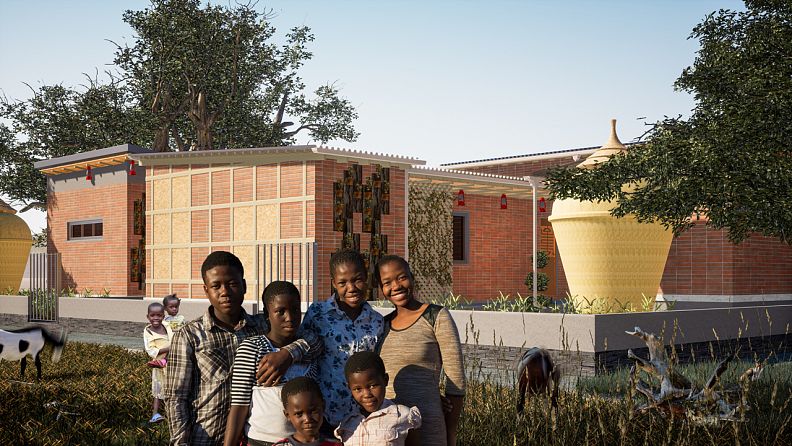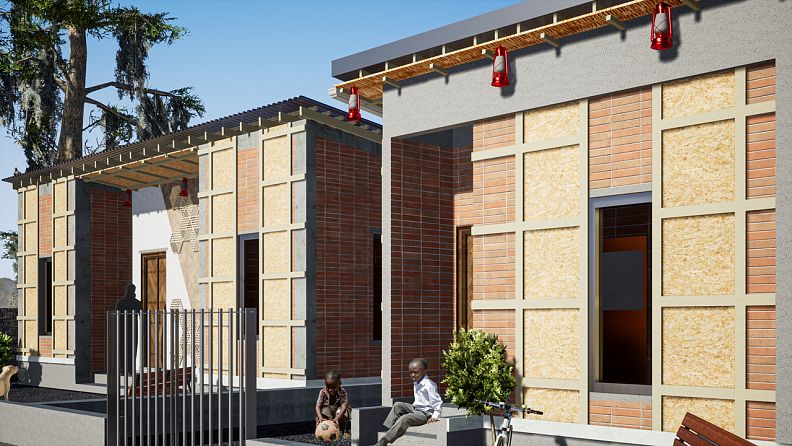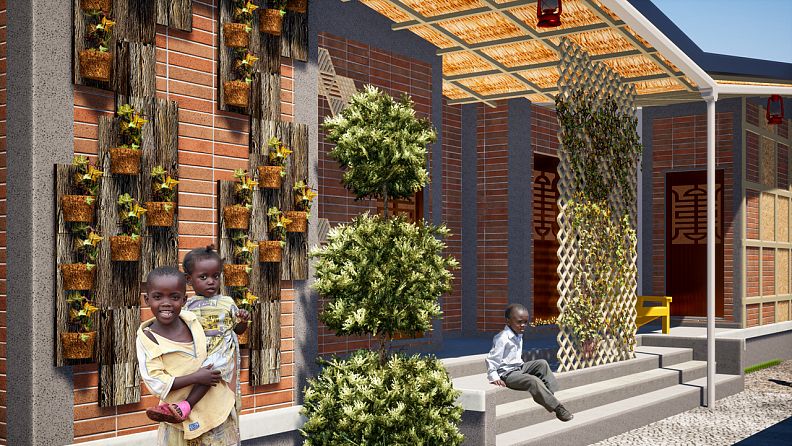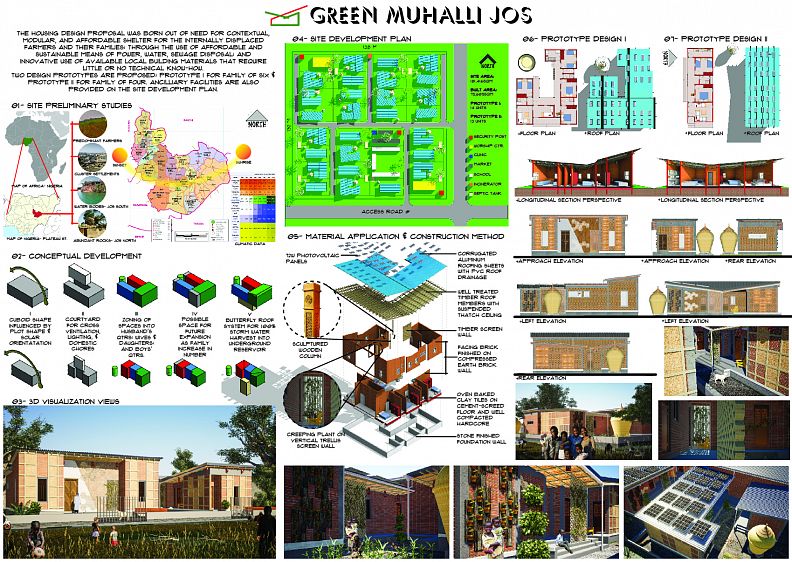FARMER’S SHELTER: Home for the Internally Displaced people of Jos, Nigeria.

Project idea
The form concept (cuboid) was born out of the regular plot shape (rectangle) and oriented towards North-South axis for optimum daylighting and reduced thermal gain. Void was carved out in order to create an open courtyard system that will permit more daylight, air for cross ventilation, and a private open space for domestic chores. The resultant form was then divided into the three major quarters; Maigida (husband’s) quarters, Yaran gida (children’s) quarters, and Matan gida (wives’ & daughters’) quarters. Cultural & Social factors such as need for privacy and seclusion of private space from the public space was duly considered. High level windows are used on the external walls of the Matan gida’s quarters due to security and privacy reasons. The traditional granary system is still maintained.
The goal is to provide New designs/constructions that are innovative, bold, affordable, modular and sustainable but informed by context, culture, and vernacular.
Due to multiple historical, sociological, environmental and political factors, this region has been convulsed in violence long before the colonial period. This has persisted and escalated in recent times. The escalation is due to a combination of the increased herdsmen/farmers militia attacks complicated by harsh economic realities and global warming.
This design initiative is aimed at reducing the effects of psychological and physical trauma through the provision of one of the most basic human needs – shelter. Relative peace is returning to the area thereby allowing considerations for the return and resettlement of the internally displaced persons (IDPs).
Project description
The design is modern yet simple, affordable, easily replicable, and culturally appropriate housing which can be built by low skilled individuals using compressed earth bricks and other locally available materials.
The design recognises and reflect the following;
1. The predominant architectural style;
So that the proposed design does not take away from the original image created with the initial design of the neighborhood/community. Therefore, a need for a marrying of the new design with the existing style in the neighborhood.
2. The predominant occupation;
Therefore, the need for appropriate crop storage and livestock habitation.
3. The predominant religion;
Therefore the need for specific design elements that allow inhabitants enjoy a degree of comfort and express liberty in this regard.
Thought was given to how individual houses will fit into the wider community that is being rebuilt as well as to how the environment will impact occupants health and well-being with factors such as quality indoor environment, sewage disposal, recycling, composting etc.
The cost of each unit is as low as possible in materials, recognizing that labour and compressed earth bricks (CEB) will be supplied by the community.
Technical information
PROJECT GREEN MUHALLI JOS
SITE DEVELOPMENT
Two design prototypes are proposed due to variation in the family size:
•Prototype I cater for family of six; while •Prototype II caters for family of four.
The Site amenities are zoned according to noise generation with respect trade wind directions, and equidistant proximity to all households. Infrastructure such as; Security Outposts, Clinic, Market space, Worship centres, Primary school, and Incinerator are all provided.
•CONCEPT DEVELOPMENT
The form concept (cuboid) was born out of the regular plot shape (rectangle) and oriented towards North-South axis for optimum daylighting and reduced thermal gain. Void was carved out in order to create an open courtyard system that will permit more daylight, air for cross ventilation, and a private open space for domestic chores. The resultant form was then divided into the three major quarters; Maigida (husband’s) quarters, Yaran gida (children’s) quarters, and Matan gida (wives’ & daughters’) quarters. Cultural & Social factors such as need for privacy and seclusion of private space from the public space was duly considered. High level windows are used on the external walls of the Matan gida’s quarters due to security and privacy reasons. The traditional granary system is still maintained.
•BUILDING MATERIAL APPLICATION
Stone is employed for foundation walls due to its abundance in Jos North and for its durability characteristics. Due to the temperate climate for most part of the year across Plateau state, compressed earth brick is used for walls due to its availability and thermal mass quality. Facing bricks is used as the wall finishing material due to its less need for frequent maintenance, reduced cost of heating and cooling, and aesthetics quality. Timber and thatch are used for the suspended ceiling system. Corrugated aluminium roofing sheets and well treated timber roof system is used for the butterfly and shed roofs. Well treated timber is used as screen walls and sculptured columns.
Oven baked clay tiles is used as floor finish on cement screed floor. Timber and glass are used for horizontal pivoted windows, while steel and timber are used for doors. Used kerosene lanterns are innovatively used as suspended lighting pendants/chandelier. Stone pebbles and shrubs are used to landscape the perimeter of the building.
•SUSTAINABILITY
Renewable source of energy (photovoltaic panels) is used to generate power. Stormwater is harvested into underground reservoir via the roof gutters, which passes through three separate filters. Septic tanks are shared between two households in order to cut cost and save space.
Vertical gardens are placed around the externals of the kitchen walls in order to increase thermal comfort and air quality, and also a daily source of fresh vegetables for the household. Wall creepers are planted on screen walls and timber wall trellis in order to increase privacy and sieve the inflow air. Thatch is also used as an additional thermal insulation and aesthetic material.
•CONSTRUCTION METHOD
Modular and Frame structure method of construction is employed for easier and faster delivery of housing. Foundation trenches are dug using manual labour to a Civil Engineer’s satisfactory depth. Concrete is used for foundation footing, and stones are used for foundation walls. Industrial nylon is used as Damp proof membrane, after compacting the hardcore.
Reinforced concrete columns are erected at strategic points and compressed earth bricks are laid to lintel level (while taking note of the various fenestrations). Reinforced concrete lintel is then casted. Compressed earth brick is then laid to the wall plate level. Timber roof system is then assembled and anchored to the wall plate. Corrugated aluminium roofing sheets are then carefully laid on the purlins and rafter with the aid of nails. Concrete is used for underground reservoir.

